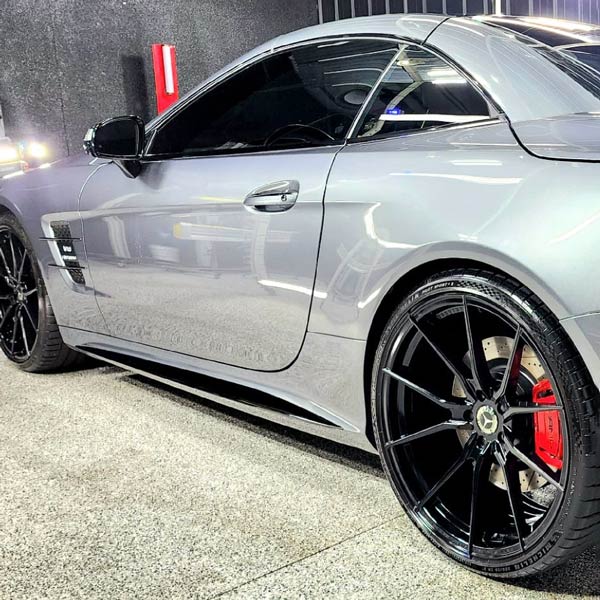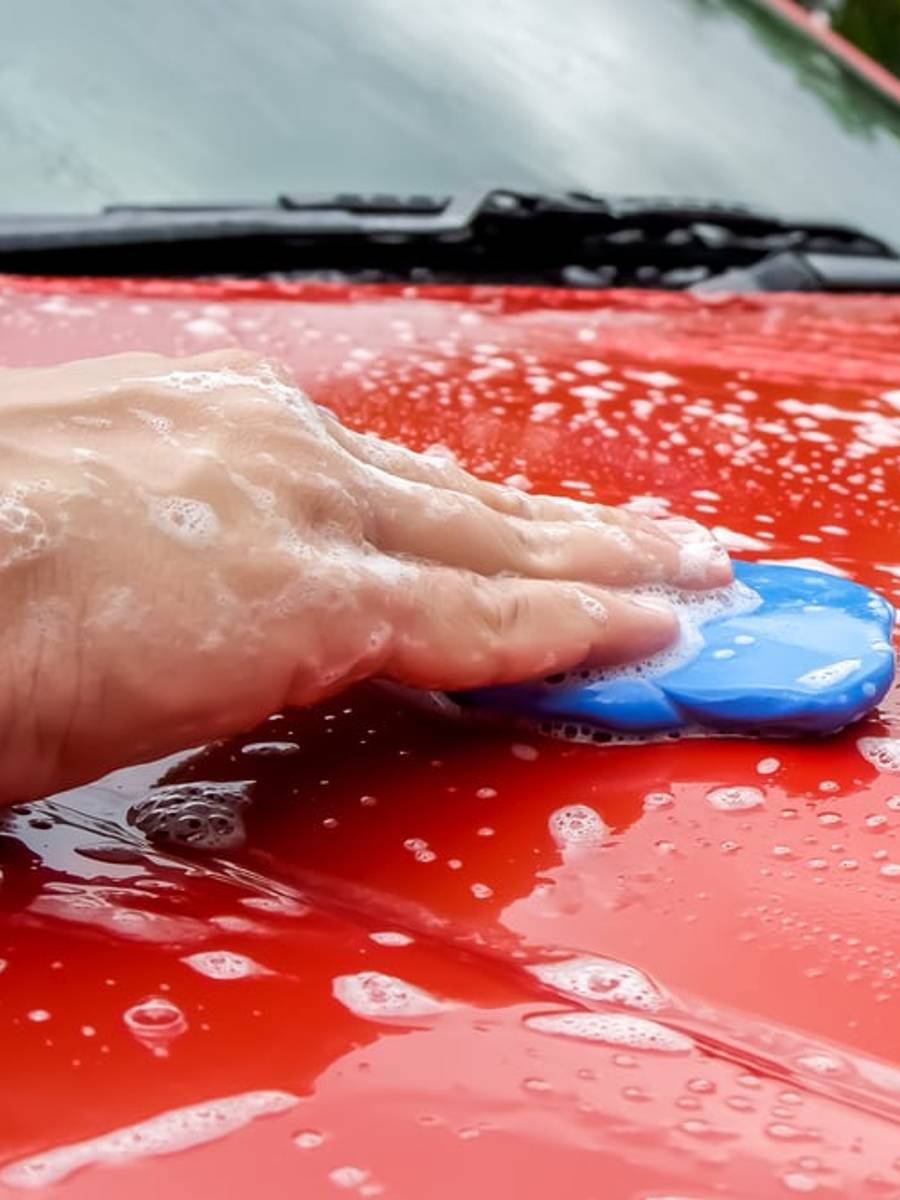How Ceramic Layer Safeguards Your Car's Paint and Maintains It Looking New
Ceramic finish has actually arised as a famous remedy for auto paint defense, supplying a durable protection versus a range of ecological dangers. The ins and outs of exactly how this innovation works and its advantages over traditional methods warrant a closer examination, disclosing engaging factors to consider this ingenious method for your car.
What Is Ceramic Coating?
Ceramic coating is regularly considered a cutting edge improvement in vehicle paint security. ceramic coating. This advanced item is a fluid polymer that chemically bonds with the car's factory paint, creating a safety layer that enhances durability and visual charm. Unlike conventional wax or sealers, which supply only short-term protection, ceramic layers use resilient results, often spanning numerous years with proper upkeep
The main components of ceramic layers are silicon dioxide (SiO2) and titanium dioxide (TiO2), which contribute to their hydrophobic residential or commercial properties. This hydrophobic nature permits water to bead and roll off the surface area, successfully avoiding impurities like dirt, crud, and bird droppings from adhering to the paint. Vehicles treated with ceramic finishes require less constant washing and are much easier to maintain.
Furthermore, ceramic layers offer UV defense, which helps avoid oxidation and fading of the paint as a result of sun exposure. This facet not just maintains the cars and truck's visual appeal however additionally contributes to its resale value gradually. Overall, ceramic coatings represent a considerable jump onward in the realm of automobile treatment, supplying a durable solution for car proprietors looking for to maintain their financial investment.
How Ceramic Finishing Functions
Ceramic finishing consists of a liquid polymer that chemically bonds with the factory paint of a vehicle (ceramic coating). The primary part of ceramic coatings is silica dioxide (SiO ₂), which provides premium solidity and strength against scratches, UV rays, and other exterior impurities.
When used properly, the finishing penetrates the microscopic pores of the paint surface area, developing a semi-permanent bond. This leads to a smooth, glossy coating that boosts the automobile's aesthetic appeal while simultaneously repelling water, dust, and gunk. The hydrophobic nature of the finishing ensures that impurities move off quickly, reducing the regularity of washing and the likelihood of scrapes during cleansing.

Advantages of Ceramic Coating
The application of ceramic covering provides various advantages that substantially improve the security and appearance of a car's paint. One of the primary benefits is its capacity to develop a durable, hydrophobic layer that drives away water, dust, and other pollutants. This home not only keeps the surface area cleaner for longer durations however also makes washing the vehicle less complicated and much less labor-intensive.
Furthermore, ceramic finishings offer superior defense versus damaging UV rays, which can result in oxidation and fading over time. ceramic coating. This UV resistance aids preserve the original shade and gloss of the automobile's paint, thus maintaining its aesthetic allure for many years
Additionally, ceramic coverings are chemically immune, using protection versus acidic pollutants such as bird droppings, tree sap, and roadway gunk. This resistance helps protect against etching and staining, which can endanger the stability of the paint.
Lastly, the longevity of ceramic finishes extends past traditional waxes and sealers, frequently long-term several years with correct maintenance. This resilient protection eventually translates into price savings, as automobile owners can decrease the regularity of reapplication and maintenance efforts. On the whole, ceramic finishings stand for a significant financial investment in lorry care.
Comparing Ceramic Layer to Conventional Approaches
Often neglected in the pursuit for optimal car security, the contrast in between ceramic covering and standard approaches such as waxing and sealants exposes considerable distinctions in durability, performance, and maintenance. Standard waxes commonly provide a short-term protective layer, commonly lasting just a few weeks to a number of months, while sealers can extend this duration to several months. On the other hand, ceramic finishings use a durable, durable guard that can sustain for numerous years when properly applied.
In terms of efficiency, ceramic coatings exhibit superior hydrophobic homes, successfully pushing back water and impurities, which stops dust and gunk from adhering to the surface. This residential or commercial property not only enhances the vehicle's look yet additionally streamlines the cleaning visit homepage process. Traditional waxes and sealers, while they might provide some water resistance, do not match the level of protection given by ceramic finishes.
The maintenance routine for both choices splits considerably. While conventional methods call for regular reapplication and upkeep, ceramic coatings are made to hold up against the roughness of daily driving with marginal treatment, making them a more reliable option for automobile enthusiasts looking for long-lasting protection. Inevitably, the option between ceramic finish and conventional methods rests on the preferred degree of security and maintenance dedication.
Maintenance Tips for Porcelain Coated Cars
Keeping a ceramic coated automobile calls for a tactical technique to ensure the longevity of the protective layer. Make use of a pH-neutral hair shampoo and microfiber wash mitts to stop damaging the covering while successfully getting rid of dust and contaminants.
Furthermore, prevent automated car washes that utilize brushes, as these can jeopardize the stability of the ceramic layer. Rather, go with a touchless over at this website wash or a hand laundry. After washing, drying out is important; make use of a top quality microfiber towel to stop water areas.
Using a ceramic-specific upkeep spray can improve the finish's hydrophobic properties and add an extra layer of protection. This should be done periodically, depending on your driving conditions.

Conclusion
Finally, ceramic finish works as an effective safety procedure for automobile paint, offering a sturdy barrier versus ecological damage and boosting the car's aesthetic charm. Its distinct properties, consisting of hydrophobicity and UV protection, add to lasting shine and tidiness. Compared to standard methods, ceramic layers present premium performance and long life, ultimately lowering maintenance initiatives. Adopting ceramic finish technology can substantially extend the life expectancy of a vehicle's exterior, guaranteeing it remains aesthetically enticing and well-protected.
Comments on “The comprehensive guide to choosing the best ceramic coating for your vehicle.”